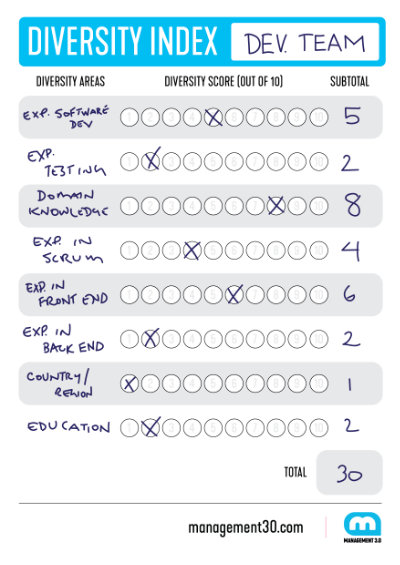by Management 3.0 Facilitator Sarika Kharbanda
Crazy number of hours had already been spent around discussions of the team members that needed to be hired to form a cross-functional team at least a week before the Product Inception meet.
During this intervention facilitation, I was hoping to educate decision makers from different functional units across the organization namely HR, procurement, contracting, IT and business that diversity would be key for their cross-functional team.
One of my lenses on Diversity:
Diversity in a team and organisation is about embracing and acknowledging different perspectives or points of view, experience, language, race, origin, gender, culture, education, skills. It felt right then that a formal training with presentations and slides might not add value. Perhaps an activity-based experiential learning would allow the decision makers themselves to come up with different ideas and conclusions. Ultimately they had to own the decisions for hiring.
I brought in the ‘Diversity Index’ practice from Management 3.0 to experiment with as an activity.

How to use the Diversity Index Practice
- Ask people to decide which Diversity areas are relevant for their context
- Get them to fill out the Diversity Index. On the left they can write down their areas of diversity.
- When the areas are filled in, ask the team to calculate the score. A point is given for each different answer. Template available at this link.
- For example, in the instance that a country would be an area of diversity and everyone was from the same country, they would score 1 point.
- If there are four people in the group and they are all from different countries, they score 4 points.
- If 2 people come from country A and one from country B and another from country C, they score 3 points.
- After deciding on the Diversity Index per area, they should write down the number on the right and calculate their total score.
- What can teams do to increase their diversity score? If there are multiple groups they can swap people from another group. Teams can also increase knowledge if the diversity area is about a specific skill.
So, here’s how my experiment went:
- We agreed on a lunch time-box of 60 minutes.
- Everyone grabbed their own lunch and decision makers from the different departments dialled into zoom from different countries.
- I facilitated the activity with two break-out rooms with four participants in each break-out zoom room.
- I decided we would use the template of Management 3.0 as-is: primarily for the reason that it would allow for customisation by the different functional managers.
Main Zoom Room Activity: 10 minutes
1. Brainstorm using Whiteboard, which Diversity areas would be relevant for this context
2. Prioritise and narrow down on Top seven relevant Diversity areas
3. Note these down to the Left in the Template
1st Breakout Room Activity: 15 minutes
1. Individually: For each area, fill out responses
2. Group:
- The group calculates the score for each Diversity area. A point is given for each different answer.
- After deciding on the Diversity Index per area, they should write down the number on the right and calculate their total score.
2nd Breakout Room Activity: 10 minutes
Repeat 1st Breakout room activity with the new group members
Return to Main Zoom room
Main Zoom Room Activity: 10 minutes
1. Approx 1 min: Note down both Group’s Total Diversity Index numbers
2. Approx 2 mins per group: Share experience with the activity
3. Approx 2-3 mins: Group think how could we increase this Diversity score?
Could we move someone to another group for this and why? Is it possible to increase the Diversity index of a specific skill in some way?
These last 2-3 mins were the A-ha moments for these 2 groups. (More on that in the Learning below) I had to moderate the discussion to time-boa and take the activity forward.
2nd Breakout Room Activity: 10 minutes
1. Repeat 1st Breakout room activity with the new group members
2. Return to Main Zoom room
Main Zoom Room Activity: 10 minutes
1. Approx 1 min to note down each new group’s Total Diversity Index numbers
2. Approx 2-3 mins per group to share experience with the activity
“We are building products that people with diverse backgrounds use, and I think we all want our company makeup to reflect the makeup of the people who use our products,” Sheryl Sandberg COO of Facebook
Key Learnings from the team, in their voice
- With one of the Breakout groups having 2 people challenge each other from their own functional context frames of reference, we see diverse perspectives could allow for constructive conflict. This would grow the team further.
- In our attempt to increase Diversity Scores, we found two team members who excelled in ‘Facilitation’ in 1 group and 2 team members who excelled in ‘Empathy‘ in the other group. It just made perfect sense to swap a member to increase each group’s Diversity. Why should it be any different when we hire people for our teams.
- Our own diversity allowed us to ‘Challenge Assumptions’. So, why should it be different for the people we hire. We want to build a top-class product. So, having diverse perspectives and having people challenge assumptions is key.
➜ Continue reading about the how to promote diversity and inclusion in the workplace.

